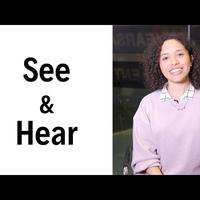See vs Hear - English In A Minute
Sehen vs. Hören - English In A Minute
Ver vs Oír - English In A Minute
See vs Hear - L'anglais en une minute
Vedere vs. Sentire - Inglese in un minuto
目で見るか耳で聞くか - English In A Minute
보고 듣기 - 1분 안에 영어 배우기
Widzieć vs Słyszeć - Angielski w minutę
Ver vs Ouvir - Inglês Num Minuto
See vs Hear - Английский за минуту
See vs Hear - Engelska på en minut
Görmek ve Duymak - Bir Dakikada İngilizce
See vs Hear - англійська за хвилину
看与听 - 一分钟英语
看與聽 - 一分鐘英語
Hi! Saskia for BBC Learning English here,
BBCラーニング・イングリッシュのサスキアです、
MERHABA! BBC Learning English için Saskia burada,
and today I'm going to tell you about
そして今日、私がお話しするのは
ve bugün size bundan bahsedeceğim
how we use verbs of perception in English.
英語で知覚を表す動詞をどう使うか。
İngilizce'de algı fiillerini nasıl kullandığımız.
There are a number of these verbs
このような動詞はいくつもある。
Bu fiillerden birkaç tane var
这些动词有很多个
but I'm just going to look at two with you now:
でも、今は2つだけ見ておこう:
ama şimdi iki tanesine bakacağım:
see and hear.
gör ve duy.
When we use these verbs, this is the form:
これらの動詞を使うときは、このような形になる:
Bu fiilleri kullandığımızda, bu biçimdir:
First, the verb of perception.
まず、知覚という動詞。
Во-первых, глагол восприятия.
İlk olarak, algı fiili.
首先,感知动词。
Then, the object of the sentence.
次に目的語。
Затем - объект предложения.
Ardından, cümlenin nesnesi.
然后,句子的宾语。
Then we have either
Entonces tenemos
そうすると、次のどちらかになる。
O zaman ikimiz de var
那么我们有
the infinitive without to or the -ing form.
toや-ing形を伴わない不定詞。
to veya -ing formu olmadan mastar.
Here's an example:
例を挙げよう:
İşte bir örnek:
以下是一个例子:
I heard him go down the stairs.
彼が階段を下りる音がした。
Я слышал, как он спускался по лестнице.
Merdivenlerden aşağı indiğini duydum.
我听见他下楼的声音。
Or:
Veya:
I heard him going down the stairs.
彼が階段を下りる音が聞こえた。
Я слышал, как он спускался по лестнице.
Merdivenlerden indiğini duydum.
我听见他走下楼梯。
There's a slight difference between these two forms:
この2つの形には若干の違いがある:
Bu iki form arasında küçük bir fark vardır:
这两种形式之间有细微的差别:
When we use the infinitive,
不定詞を使うとき
Mastarı kullandığımızda,
当我们使用不定式时,
it suggests that we hear or see
私たちが聞いたり見たりすることを示唆している
duyduğumuzu veya gördüğümüzü öne sürüyor
它表明我们听到或看到
the whole action or event.
行動や出来事全体。
все действие или событие.
tüm eylem veya olay.
整个动作或事件。
Using the –ing form suggests that
ing形を使うと、次のようになる。
–ing formunu kullanmak şunu önerir:
使用 –ing 形式表明
we hear or see something in progress.
何かが進行しているのを聞いたり、見たりする。
мы слышим или видим, как что-то происходит.
devam eden bir şey duyar veya görürüz.
我们听到或看到某事正在发生。
'I saw her cross the street'
彼女が通りを横切るのを見た
«Я видел, как она переходила улицу»
'Karşıdan karşıya geçerken gördüm'
“我看到她过马路”
means I saw her cross from one side to the other.
というのは、彼女が左右に交差するのを見たからだ。
значит, я видел, как она переходила с одной стороны на другую.
onu bir yandan diğer yana çapraz gördüm demek.
意思是我看到她从一侧穿过到另一侧。
'I saw her crossing the street'
彼女が通りを横切るのを見た
Vi-a a atravessar a rua
«Я видел, как она переходила улицу»
'Karşıdan karşıya geçerken gördüm'
“我看到她过马路”
means I saw her in the middle – on the way across.
signifie que je l'ai vue au milieu - sur le chemin de la traversée.
というのは、途中で彼女を見たんだ。
значит, я видел ее посередине — на пути.
onu ortada gördüğüm anlamına gelir - karşıya geçerken.
意思是我在中间——在穿过的路上——看见了她。

